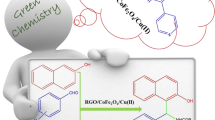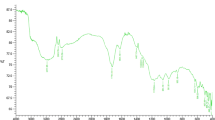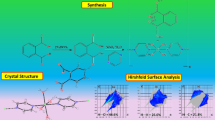Abstract
Coordination bonding of Ni(II) tetraazamacrocyclic (TAMC) complexes to carboxylic groups of organic polymers and graphene oxide paper (GOP) is proposed for a facile generation of paramagnetic centers by combining two diamagnetic components. The coordination functionalization occurs under basic conditions in water solution at room temperature. The coordination configuration of central Ni(II) changes from tetracoordinated square-planar to hexacoordinated pseudooctahedral, which implies the conversion from low-spin to high-spin nickel centers. In the case of organic polymers, the coordination bonding of Ni(II) macrocycles gives rise to characteristic changes in coloration (from yellow-orange to violet-blue), as well as clearly manifests itself in UV–visible, FTIR and EPR spectra. In the case of GOP, in addition to evident changes in FTIR spectra, morphological alterations in the mat surface and an increase in the mat thickness are observed in SEM images, which can be explained by an intercalating effect of voluminous macrocyclic cations, as well as by partial disintegration of GOP structure due to the liquid-phase treatment. The effective magnetic moments of tetraazamacrocycles attached to organic polymers vary from 0.88 to 1.47 BM, whereas for GOP considerably higher values of 2.10 and 2.87 BM were obtained.










Similar content being viewed by others
References
Fujii S, Hamasaki H, Abe H, Yamanaka S, Ohtaka A, Nakamura E, Nakamura Y (2013) One-step synthesis of magnetic iron–conducting polymer–palladium ternary nanocomposite microspheres with applications as a recyclable catalyst. J Mater Chem A 1:4427–4430
Liu B, Zhang D, Wang J, Chen C, Yang X, Li C (2013) Multilayer magnetic composite particles with functional polymer brushes as stabilizers for gold nanocolloids and their recyclable catalysis. J Phys Chem C 117:6363–6372
Yan H, Cheng X, Sun N (2013) Synthesis of multi-core-shell magnetic molecularly imprinted microspheres for rapid recognition of dicofol in tea. J Agric Food Chem 61:2896–2901
Pavía-Sanders A, Zhang S, Flores JA, Sanders JE, Raymond JE, Wooley KL (2013) Robust magnetic/polymer hybrid nanoparticles designed for crude oil entrapment and recovery in aqueous environments. ACS Nano 7:7552–7561
Takafuji M, Ide S, Ihara H, Xu Z (2004) Preparation of poly(1-vinylimidazole)-grafted magnetic nanoparticles and their application for removal of metal ions. Chem Mater 16:1977–1983
Döbbelin M, Jovanovski V, Llarena I, Marfil LJC, Cabañero G, Rodriguez J, Mecerreyes D (2011) Synthesis of paramagnetic polymers using ionic liquid chemistry. Polym Chem 2:1275–1278
Xia Z, Yu X, Zhang T, Yuan X, Ren L (2019) Inorganic/organic hybrid magnetic polymers based on POSS and pyridinium FeCl4: the effect of self-assembly. Polym Chem 10:4604–4610
Yu X, Yuan X, Zhao Y, Ren L (2015) Synthesis of paramagnetic polymers based on polyethyleneimine (PEI). RSC Adv 5:92207–92211
Yen SK, Janczewski D, Lakshmi JL, Dolmanan SB, Tripathy S, Ho VH, Vijayaragavan V, Hariharan A, Padmanabhan P, Bhakoo KK, Sudhaharan T, Ahmed S, Zhang Y, Selvan ST (2013) Design and synthesis of polymer-functionalized NIR fluorescent dyes–magnetic nanoparticles for bioimaging. ACS Nano 7:6796–6805
Li K, Ding D, Huo D, Pu KY, Thao NNP, Hu Y, Li Z, Liu B (2012) Conjugated polymer based nanoparticles as dual-modal probes for targeted in vivo fluorescence and magnetic resonance imaging. Adv Funct Mater 22:3107–3115
Sun M, Zhang HY, Liu BW, Liu Y (2013) Construction of a supramolecular polymer by bridged bis(permethyl-β-cyclodextrin)s with porphyrins and its highly efficient magnetic resonance imaging. Macromolecules 46:4268–4275
Villaraza AJL, Bumb A, Brechbiel MW (2010) Macromolecules, dendrimers, and nanomaterials in magnetic resonance imaging: the interplay between size, function, and pharmacokinetics. Chem Rev 110:2921–2959
Bogdanov AA Jr, Weissleder R, Frank HW, Bogdanova AV, Nossif N, Schaffer BK, Tsai E, Papisov MI, Brady TJ (1993) A new macromolecule as a contrast agent for MR angiography: preparation, properties, and animal studies. Radiology 187:701–706
Cyran CC, Fu Y, Raatschen H-J, Rogut V, Chaopathomkul B, Shames DM, Wendland MF, Yeh BM, Brasch RC (2008) New macromolecular polymeric MRI contrast agents for application in the differentiation of cancer from benign soft t ssues. J Magn Reson Imaging 27:581–589
Bilalis P, Chatzipavlidis A, Tziveleka LA, Boukos N, Kordas G (2012) Nanodesigned magnetic polymer containers for dual stimuli actuated drug controlled release and magnetic hyperthermia mediation. J Mater Chem 22:13451–13454
Arruebo M, Fernández-Pacheco R, Ibarra MR, Santamaría J (2007) Magnetic nanoparticles for drug delivery. Nano Today 2:22–32
Pantel K, Brakenhoff RH, Brandt B (2008) Detection, clinical relevance and specific biological properties of disseminating tumour cells. Nat Rev Cancer 8:329–340
Horák D, Španová A, Tvrdíková J, Rittich B (2011) Streptavidin-modified magnetic poly(2-hydroxyethyl methacrylate-co-glycidyl methacrylate) microspheres for selective isolation of bacterial DNA. Eur Polym J 47:1090–1096
Chung TH, Chang JY, Lee WC (2009) Application of magnetic poly(styrene-glycidyl methacrylate) microspheres for immunomagnetic separation of bone marrow cells. J Magn Magn Mater 321:1635–1638
Lisi S, Gargiani P, Scardamaglia M, Brookes NB, Sessi V, Mariani C, Betti MG (2015) Graphene-induced magnetic anisotropy of a two-dimensional iron phthalocyanine network. J Phys Chem Lett 6:1690–1695
Hermanns CF, Tarafder K, Bernien M, Krüger A, Chang YM, Oppeneer PM, Kuch W (2013) Magnetic coupling of porphyrin molecules through graphene. Adv Mater 25:3473–3477
Bhandary S, Eriksson O, Sanyal B (2013) Defect controlled magnetism in FeP/graphene/Ni(111). Sci Rep 3:3405-1–3405-6
Klar D, Bhandary S, Candini A, Joly L, Ohresser P, Klyatskaya S, Schleberger M, Ruben M, Affronte M, Eriksson O, Sanyal B, Wende H (2014) Field-regulated switching of the magnetization of Co-porphyrin on graphene. Phys Rev B 89:144411-1–144411-5
Mao J, Zhang H, Jiang Y, Pan Y, Gao M, Xiao W, Gao H-J (2009) Tunability of supramolecular kagome lattices of magnetic phthalocyanines using graphene-based moiré patterns as templates. J Am Chem Soc 131:14136–14137
Candini A, Bellini V, Klar D, Corradini V, Biagi R, De Renzi V, Kummer K, Brookes NB, del Pennino U, Wende H, Affronte M (2014) Ferromagnetic exchange coupling between Fe phthalocyanine and Ni(111) surface mediated by the extended states of graphene. J Phys Chem C 118:17670–17676
Candini A, Klyatskaya S, Ruben M, Wernsdorfer W, Affronte M (2011) Graphene spintronic devices with molecular nanomagnets. Nano Lett 11:2634–2639
Hung AH, Holbrook RJ, Rotz MW, Glasscock CJ, Mansukhani ND, MacRenaris KW, Manus LM, Duch MC, Dam KT, Hersam MC, Meade TJ (2014) Graphene oxide enhances cellular delivery of hydrophilic small molecules by co-incubation. ACS Nano 8:10168–10177
Liang X, Sadler PJ (2004) Cyclam complexes and their applications in medicine. Chem Soc Rev 33:246–266
Whimp PO, Bailey MF, Curtis NF (1970) Some cyclic tetra-amines and their metal-ion complexes. Part VI. The crystal structure of acetato-C-rac-(5,7,7,12,14,14-hexamethyl-1,4,8,11-tetra-azacyclotetradecane)nickel(II) perchlorate. J Chem Soc A. https://pubs.rsc.org/en/content/articlelanding/1970/J1/J19700001956#!divAbstract.
Basiuk EV, Basiuk VA, Gómez-Lara J, Toscano RA (2000) A bridged high-spin complex bis-[Ni(II)(rac-5,5,7,12,12,14-hexamethyl-1,4,8,11-tetraazacyclotetradecane)]-2,5-pyridinedicarboxylate diperchlorate monohydrate. J Incl Phenom Macrocycl Chem 38:45–56
Basiuk EV, Basiuk VA, Hernández-Ortega S, Martínez-García M, Saniger-Blesa J-M (2001) (C-rac-5,5,7,12,12,14-Hexamethyl-1,4,8,11-tetraazacyclotetradecane-κ4N)(nicotinato-O,O′)nickel(II) perchlorate. Acta Crystallogr C C57:553–555
Basiuk VA, Alzate-Carvajal N, Henao-Holguín LV, Rybak-Akimova EV, Basiuk EV (2016) Coordination functionalization of graphene oxide with tetraazamacrocyclic complexes of nickel(II): generation of paramagnetic centers. Appl Surf Sci 371:16–27
Basiuk VA, Rybak-Akimova EV, Basiuk EV (2017) Graphene oxide and nanodiamond: same carboxylic groups, different complexation properties. RSC Adv 7:17442–17450
Hay RW, Lawrance GA, Curtis NF (1975) A convenient synthesis of the tetra-aza-macrocyclic ligands trans-[14]-diene, tet a, and tet b. J Chem Soc Perkin Trans 1(6):591–593
Tait AM, Busch DH (1978) 5,5,7,12,12,14-Hexamethyl-1,4,8,11-tetraazacyclotetradecane (5,5,7,12,12,14-Me6[14]ane-1,4,8,11-N4) complexes. In: Douglas BE (ed) Inorganic syntheses, vol 18. Wiley, New York, pp 10–15
Barefield EK, Wagner F, Herlinger AW, Dahl AR, Holt S (1976) (1,4,8,11-tetraazacyclotetradecane)nickel(II) perchlorate and 1,4,8,11-tetraazacyclotetradecane. In: Basolo F (ed) Inorganic syntheses, vol 16. Wiley, New York, pp 220–225
Curtis NF, Curtis YM (1965) Some nitrato-amine nickel(II) compounds with monodentate and bidentate nitrate ions. Inorg Chem 4:804–809
Krzystek J, Park J-H, Meisel MW, Hitchman MA, Stratemeier H, Brunel L-C, Telser J (2002) EPR spectra from “EPR-silent” species: high-frequency and high-field EPR spectroscopy of pseudotetrahedral complexes of nickel(II). Inorg Chem 41:4478–4487
Reedijk J, Nieuwenhuijse B (1972) Interpretation of E.P.R.-spectra of powdered octahedral nickel(II) complexes with nitrogen-donor ligands. Rec Trav Chim 91:533–551
Witteveen HT, Rutten WLC, Reedijk J (1975) Susceptibility measurements on the linear-chain compounds NiX2L2 with X = Cl, Br and L = pyrazole, pyridine. J Inorg Nucl Chem 37:913–919
Amendola V, Fabbrizzi L, Foti F, Licchelli M, Mangano C, Pallavicini P, Poggi A, Sacchi D, Taglietti A (2006) Light-emitting molecular devices based on transition metals. Coord Chem Rev 250:273–299
Ioniţă M, Vlăsceanu GM, Watzlawek AA, Voicu SI, Burns JS, Iovu H (2017) Graphene and functionalized graphene: extraordinary prospects for nanobiocomposite materials. Compos B Eng 121:34–57
Loh KB, Bao Q, Ang PK, Yang J (2010) The chemistry of graphene. J Mater Chem 20:2277–2289
Park S, Dikin DA, Nguyen ST, Ruoff RS (2009) Graphene oxide sheets chemically cross-linked by polyallylamine. J Phys Chem C 113:15801–15804
Stankovich S, Dikin DA, Compton OC, Dommett GHB, Ruoff RS, Nguyen ST (2010) Systematic post-assembly modification of graphene oxide paper with primary alkylamines. Chem Mater 22:4153–4157
Huang W (2017) Graphene oxide papers, chapter 1. In: Huang W (ed) Nanopapers: from nanochemistry and nanomanufacturing to advanced applications, 1st edn. Elsevier, Amsterdam, pp 1–26
Alzate-Carvajal N, Acevedo-Guzmán DA, Meza-Laguna V, Farías MH, Pérez-Rey LA, Abarca-Morales E, García-Ramírez VA, Basiuk VA, Basiuk EV (2018) One-step nondestructive functionalization of graphene oxide paper with amines. RSC Adv 8:15253–15265
Acknowledgements
Financial support from the National Autonomous University of Mexico (UNAM, grant DGAPA-IN101118) and from the National Council of Science and Technology of Mexico (CONACYT, Grant 250655) is greatly appreciated. The authors acknowledge the University Laboratory of Spectroscopic Characterization of UNAM (Laboratorio Universitario de Caracterización Espectroscópica, LUCE_ICAT_UNAM) for the opportunity to measure FTIR, Raman and UV–visible spectra, and Dr. Victor Meza-Laguna (Instituto de Ciencias Nucleares UNAM) for the acquisition of SEM images and EDS spectra. V. A. B. and E. V. B. also thank the “Programa de Apoyos para la Superación del Personal Académico” (PASPA) UNAM for supporting their sabbatical stay at CIICAp UAEM. C. C. O.-B. is indebted to the Master Degree Program in Chemical Sciences of UNAM and to CONACyT for MSc scholarship.
Author information
Authors and Affiliations
Corresponding authors
Ethics declarations
Conflict of interest
No conflict of interest exists.
Additional information
Publisher's Note
Springer Nature remains neutral with regard to jurisdictional claims in published maps and institutional affiliations.
Rights and permissions
About this article
Cite this article
Basiuk, E.V., Ocampo-Bravo, C.C., Gómez-Vidales, V. et al. Generation of paramagnetic centers in carboxylated materials via coordination attachment of diamagnetic tetraazamacrocyclic complexes of nickel(II). J Mater Sci 55, 5364–5377 (2020). https://doi.org/10.1007/s10853-020-04372-5
Received:
Accepted:
Published:
Issue Date:
DOI: https://doi.org/10.1007/s10853-020-04372-5




